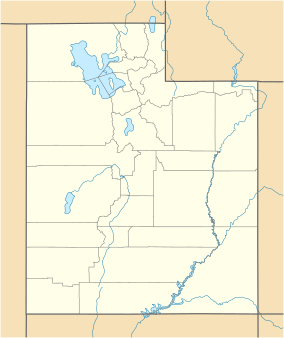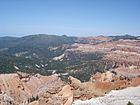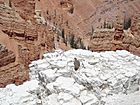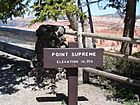Cedar Breaks National Monument facts for kids
Quick facts for kids Cedar Breaks National Monument |
|
|---|---|
|
IUCN Category V (Protected Landscape/Seascape)
|
|

Cedar Breaks amphitheater
|
|
| Location | Iron County, Utah, U.S. |
| Area | 6,155 acres (24.91 km2) |
| Created | August 22, 1933 |
| Visitors | 688,644 (in 2022) |
| Governing body | National Park Service |
| Website | Cedar Breaks National Monument |
Cedar Breaks National Monument is a special place in Utah, near Cedar City. It's like a giant natural bowl, or an amphitheater, carved into the earth. This amazing bowl stretches about 3 miles wide and is over 2,000 feet deep! Imagine looking down from the rim, which is more than 10,000 feet above sea level. That's super high up!
Just outside the monument, you can see a tall mountain called Brian Head. The rocks here look a lot like those at Bryce Canyon National Park, but they are even more worn away. Because Cedar Breaks is so high up, it gets a lot of snow. This means some parts of the park are closed to cars from October to May. The visitor center on the rim is open from June to October. Lots of people visit this monument every year to see its beauty.
Contents
Animals and Plants of Cedar Breaks
You can often spot cool animals living in this high-up area.
Wildlife You Might See
Look out for mule deer and porcupines. You might also see smaller animals like marmots, golden-mantled ground squirrels, and chipmunks. Even though mountain lions live here, they are very shy and rarely seen. Birds like the Clark's nutcracker, violet-green swallows, and common ravens fly overhead.
Amazing Trees and Flowers
Cedar Breaks is home to the bristlecone pine. These trees are some of the oldest living things on Earth! Some here are more than 1,600 years old. Imagine how much history they've seen! You'll also find other trees like Aspen, Engelmann spruce, and subalpine fir.
When spring arrives in June, the canyon rim bursts with colorful wildflowers. They bloom all summer long. You can see beautiful flowers like Colorado columbine, bright red scarlet paintbrush, and many others. It's like a natural flower garden!
How Cedar Breaks Was Formed
This incredible amphitheater is part of the Colorado Plateau. Over millions of years, the land was pushed up, and then wind and water slowly carved away the rocks.
Rocks and Colors
The rocks here are made of shale, limestone, and sandstone. These layers were laid down at the bottom of a huge ancient lake about 60 million years ago. Even today, the canyon is still eroding, losing about 2 inches of rock every 5 years!
The rocks get their amazing colors from iron and manganese. Iron makes the reds, oranges, and yellows. Manganese creates shades of purple. That's why Native Americans called it the Circle of Painted Cliffs.
Why It's Called "Breaks"
This area is a type of badlands. This means it has steep canyons, tall spires, and cliffs that are hard to travel through. Early settlers called these difficult lands "badlands" or "breaks." They added "cedar" because of the many juniper trees that grow here, which they often mistakenly called cedars.
Cedar Breaks officially became a National Monument in 1933.
Visiting Cedar Breaks
There are two main hiking trails in the monument. You can also find a campsite near the canyon rim. The trails are easy to moderately challenging and range from about half a mile to 5 miles long. It's a great place to explore and see nature up close!
Gallery
- Cedar Breaks
-
Golden-mantled ground squirrel on the limestone canyon rim













